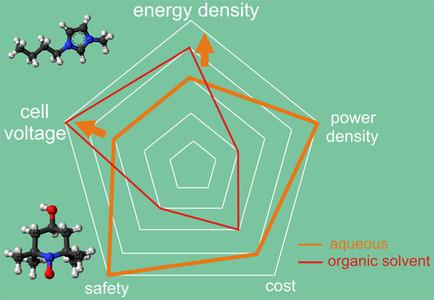当前位置:
X-MOL 学术
›
ChemElectroChem
›
论文详情
Our official English website, www.x-mol.net, welcomes your
feedback! (Note: you will need to create a separate account there.)
Toward High‐Voltage, Energy‐Dense, and Durable Aqueous Organic Redox Flow Batteries: Role of the Supporting Electrolytes
ChemElectroChem ( IF 3.5 ) Pub Date : 2018-12-10 , DOI: 10.1002/celc.201801505 Ruiyong Chen 1, 2
ChemElectroChem ( IF 3.5 ) Pub Date : 2018-12-10 , DOI: 10.1002/celc.201801505 Ruiyong Chen 1, 2
Affiliation

|
Sustainable energy supply from renewable sources requires highly efficient and economically competitive energy‐storage technologies. With flexible design, high energy‐storage efficiency, and long‐term cyclability, redox flow batteries are superior candidates for peak shaving and load leveling for smart grids in the energy generation, storage and distribution networks. With natural abundance, structural diversity and tunability, redox‐active organic species as valuable alternatives to the traditional inorganic‐based materials are promising to tackle the resource and performance limitations. To design aqueous organic redox flow batteries toward energy‐dense, high‐rate performance and durability, in this Review, strategies to maximize the cell voltage, effective concentration of organic species, and operating current density are discussed. Besides the inherent nature of the organic molecules, suitable solvents and supporting ions can affect their solvation behavior and promote their chemical stability.
中文翻译:

走向高压,高能量和耐用的水性有机氧化还原液流电池:支持电解质的作用
来自可再生能源的可持续能源供应需要高效且经济上具有竞争力的储能技术。凭借灵活的设计,高的储能效率和长期可循环性,氧化还原液流电池是能量生成,存储和分配网络中智能电网的调峰和负载均衡的极佳候选者。具有自然丰富性,结构多样性和可调节性的氧化还原活性有机物有望替代传统的无机材料,从而有望解决资源和性能方面的局限性。为了设计含水有机氧化还原液流电池,使其朝着能量密集,高速率性能和耐久性的方向发展,在本综述中,我们讨论了最大化电池电压,有机物有效浓度和工作电流密度的策略。
更新日期:2018-12-10
中文翻译:

走向高压,高能量和耐用的水性有机氧化还原液流电池:支持电解质的作用
来自可再生能源的可持续能源供应需要高效且经济上具有竞争力的储能技术。凭借灵活的设计,高的储能效率和长期可循环性,氧化还原液流电池是能量生成,存储和分配网络中智能电网的调峰和负载均衡的极佳候选者。具有自然丰富性,结构多样性和可调节性的氧化还原活性有机物有望替代传统的无机材料,从而有望解决资源和性能方面的局限性。为了设计含水有机氧化还原液流电池,使其朝着能量密集,高速率性能和耐久性的方向发展,在本综述中,我们讨论了最大化电池电压,有机物有效浓度和工作电流密度的策略。











































 京公网安备 11010802027423号
京公网安备 11010802027423号